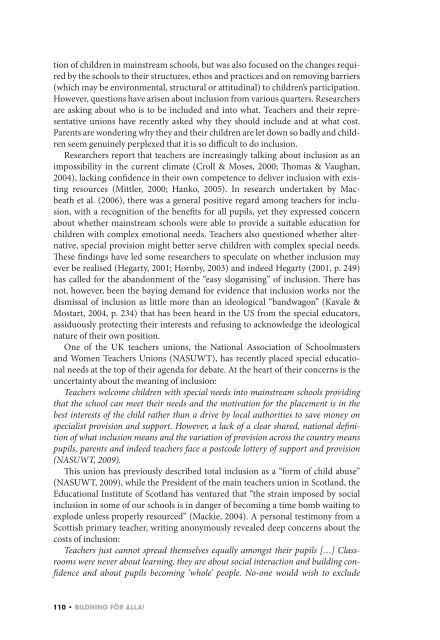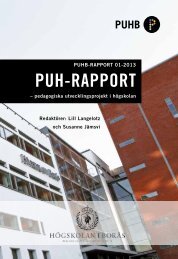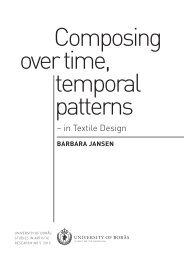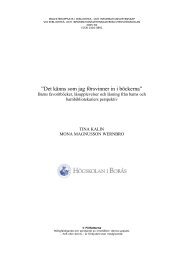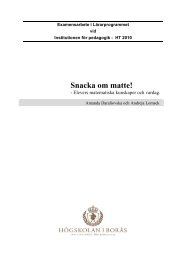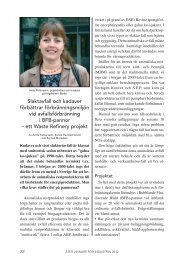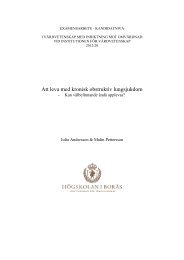Bildning för alla! - DiVA
Bildning för alla! - DiVA
Bildning för alla! - DiVA
You also want an ePaper? Increase the reach of your titles
YUMPU automatically turns print PDFs into web optimized ePapers that Google loves.
tion of children in mainstream schools, but was also focused on the changes required<br />
by the schools to their structures, ethos and practices and on removing barriers<br />
(which may be environmental, structural or attitudinal) to children’s participation.<br />
However, questions have arisen about inclusion from various quarters. Researchers<br />
are asking about who is to be included and into what. Teachers and their representative<br />
unions have recently asked why they should include and at what cost.<br />
Parents are wondering why they and their children are let down so badly and children<br />
seem genuinely perplexed that it is so difficult to do inclusion.<br />
Researchers report that teachers are increasingly talking about inclusion as an<br />
impossibility in the current climate (Croll & Moses, 2000; Thomas & Vaughan,<br />
2004), lacking confidence in their own competence to deliver inclusion with existing<br />
resources (Mittler, 2000; Hanko, 2005). In research undertaken by Macbeath<br />
et al. (2006), there was a general positive regard among teachers for inclusion,<br />
with a recognition of the benefits for all pupils, yet they expressed concern<br />
about whether mainstream schools were able to provide a suitable education for<br />
children with complex emotional needs. Teachers also questioned whether alternative,<br />
special provision might better serve children with complex special needs.<br />
These findings have led some researchers to speculate on whether inclusion may<br />
ever be realised (Hegarty, 2001; Hornby, 2003) and indeed Hegarty (2001, p. 249)<br />
has called for the abandonment of the “easy sloganising” of inclusion. There has<br />
not, however, been the baying demand for evidence that inclusion works nor the<br />
dismissal of inclusion as little more than an ideological “bandwagon” (Kavale &<br />
Mostart, 2004, p. 234) that has been heard in the US from the special educators,<br />
assiduously protecting their interests and refusing to acknowledge the ideological<br />
nature of their own position.<br />
One of the UK teachers unions, the National Association of Schoolmasters<br />
and Women Teachers Unions (NASUWT), has recently placed special educational<br />
needs at the top of their agenda for debate. At the heart of their concerns is the<br />
uncertainty about the meaning of inclusion:<br />
Teachers welcome children with special needs into mainstream schools providing<br />
that the school can meet their needs and the motivation for the placement is in the<br />
best interests of the child rather than a drive by local authorities to save money on<br />
specialist provision and support. However, a lack of a clear shared, national definition<br />
of what inclusion means and the variation of provision across the country means<br />
pupils, parents and indeed teachers face a postcode lottery of support and provision<br />
(NASUWT, 2009).<br />
This union has previously described total inclusion as a “form of child abuse”<br />
(NASUWT, 2009), while the President of the main teachers union in Scotland, the<br />
Educational Institute of Scotland has ventured that “the strain imposed by social<br />
inclusion in some of our schools is in danger of becoming a time bomb waiting to<br />
explode unless properly resourced” (Mackie, 2004). A personal testimony from a<br />
Scottish primary teacher, writing anonymously revealed deep concerns about the<br />
costs of inclusion:<br />
Teachers just cannot spread themselves equally amongst their pupils […] Classrooms<br />
were never about learning, they are about social interaction and building confidence<br />
and about pupils becoming ‘whole’ people. No-one would wish to exclude<br />
110 • BilDning fÖr AllA!


